Lilium formosanum
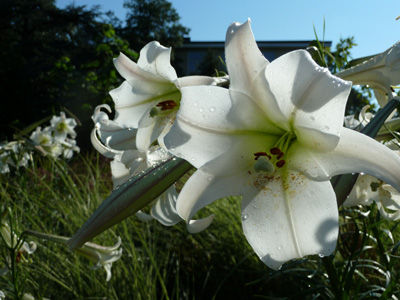 Lilies bear deep and rich historical significance for many cultures. The genus name Lilium is derived from a Celtic word meaning “whiteness.” In Greek lore, the lily was dedicated to Hera, the wife of Zeus. According to Roman legend, when the rising Venus beheld the flawless beauty of the lily, she became enraged with jealousy. Unable to withstand an object that rivaled her beauty, she commanded a yellow pistil to spring forth, thus marring the snow-white flower.
Lilies bear deep and rich historical significance for many cultures. The genus name Lilium is derived from a Celtic word meaning “whiteness.” In Greek lore, the lily was dedicated to Hera, the wife of Zeus. According to Roman legend, when the rising Venus beheld the flawless beauty of the lily, she became enraged with jealousy. Unable to withstand an object that rivaled her beauty, she commanded a yellow pistil to spring forth, thus marring the snow-white flower.
Both Jewish and Christian faiths reference the lily; the flower is mentioned in both the old and new testament. It was long thought that the flowers and bulbs possessed medicinal properties, though we know the genus has no such value. Hundreds, if not thousands of recipes were concocted in Elizabethan times and prescribed for ailments ranging from burns and sores to arthritic symptoms.
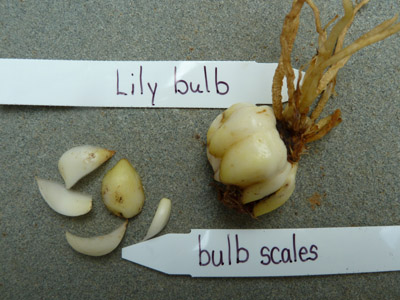
Bulb and bulb scales of Lilium formosanum. photo credit: J. Coceano
The genus Lilium is vast: by some accounts there are around 110 species in Liliaceae. The common name lily is a loose term and is often tagged to other genus such as Hemerocallis, the daylily, and Zephyranthes, the rain lily, that possess a similar flower shape, but bear no family relationship. A majority of the species are native to the temperate regions of the Northern hemisphere.
Native to Taiwan, the formosa lily, Lilium formosanum, is a regal representative of the genus. Sturdy stems, averaging 4 to 7 feet tall bear clusters of fragrant white flowers. Individual trumpet-like flowers reach 8-12 inches in length. The flower’s throat bears a faint yellow glow. The outer petals are pure white save for a light rose streak that runs the length of each petal. As blossoms give way to fruit, seedpods inflate, turn upward and persist throughout the autumn and early winter.
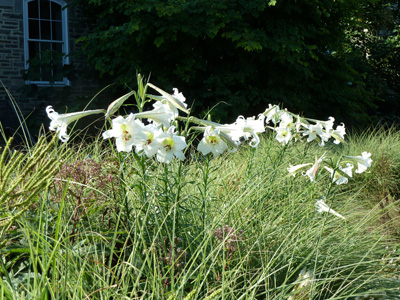
L. formosanum and M. sinensis 'Morning Light' grow well together in the John W. Nason Garden. photo credit: J. Coceano
Site Lilium formosanum in full sun. Provide a slightly acidic, moisture-retentive loamy soil. While most lilies, L. formosanum included, require high light levels, they appreciate cool root zones. To accomplish this, grow lilies amongst ornamental grasses or other airy plants such as coneflowers or Japanese anemones.
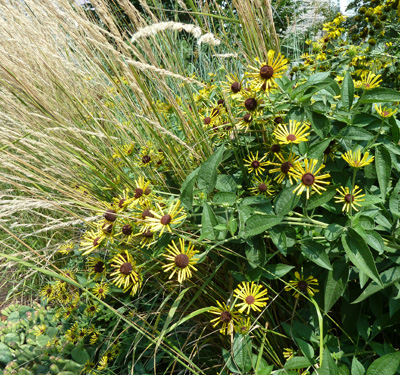
Rudbeckia subtomentosa 'Henry Eilers' and ornamental grasses make great pairings with L. formosanum. photo credit: J. Coceano
A group of L. formosanum is beautifully paired with Miscanthus sinensis ‘Morning Light’ in the John W. Nason Garden. The grass provides shade necessary for a cool root run and doesn’t impede photosynthesis. Fluffy miscanthus seed heads appear as the lily flowers fade and drop. During spring cleanup, cut spent stalks to the ground.
Lilies make spectacular cut flowers. Harvest just as the flowers begin to open. It is advisable to cut off the pollen-bearing stamens as the pollen is difficult (if not impossible) to remove from fabric.
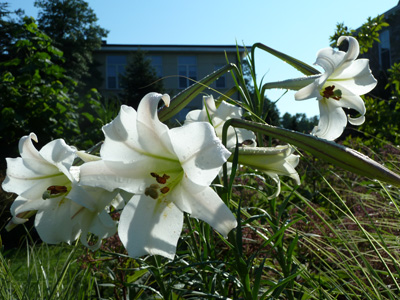
L. formosanum in bloom in the John W. Nason Garden. photo credit: J. Coceano
Bulbs can be planted anytime from spring to fall. The plant will self-seed though it will take several seasons before seedlings bear flowers. Other means of propagation include breaking off bulb scales and division of mature clumps.
For best display plant multiple bulbs in several locations throughout the garden. The Scott Associates’ Plant Sale will offer Lilium formosanum, perfect for fall planting.





No Comments